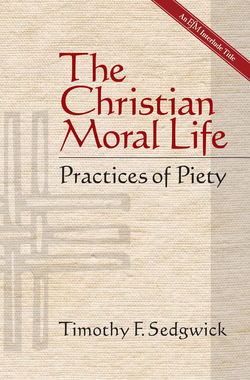Читать книгу The Christian Moral Life - Timothy F. Sedgwick - Страница 8
[CHAPTER 1] Describing the Christian Life
ОглавлениеWhat needs to be done? What do I want to do? Who should I call? Who do I want to call? Our daily lives are given in the responses we make to such questions. We are most often aware of our responses in times of change. Change raises the question, “What is most important to us?” “What do we truly love and desire?”
My students often accuse me of asking “cosmic questions.” The cosmic questions, however, are simply asking what is the pattern in the answers we give to the ordinary questions of our daily lives. How often I have heard such questions as these from my two daughters during their teenage years: What should I do today? What should I wear? Do I want to be by myself or go out with friends? Should I buy some new pants? Should I stay up and study some more or go to sleep now and study in the morning? What courses should I take? What am I going to do this summer? Our responses to such questions are much like sentences in the unfolding of a larger story. One sentence leads to the next. As we look back we discern a drama marked by different scenes, characters, and conflicts.1
Deep guidance for the moral life cannot be gained by narrowly focusing on the crises of our daily lives. In asking what I should do this day, I can be helped by writing down a list of possibilities and then identifying what I like and dislike about each item. In focusing only on the decisions, however, I cannot understand what values and loves are most important to my life. Deep guidance can come only from an understanding of the stories that express the drama I see myself living. These range from my family stories to the stories given in the different cultures in which I live. In turn, I seek some story that both makes sense of my life’s stories and expresses a larger meaning and purpose to which I can give myself. What makes understanding Christian faith and the moral life difficult are the different stories of Christian faith and life that have been offered.
Often I find our situation like living in a city where I encounter fragments of stories but do not know how these fit together. For example, in joining in Christian worship I sing songs that celebrate the death and resurrection of Jesus. These evoke another world, holy and full of mystery, given in silence and prayer. But making sense of prayer and this ancient language of sacrifice and blessing is something that involves deciphering. I hear in a sermon that I am baptized into a new life, and I feel something new in this community of worship. But I cannot make sense of what that means when I hear the radical demands in the gospel to sell everything and to come follow in Jesus’ way. I sense something of the Christian story as a way of life, but I don’t know how it fits with the other worlds of meaning and value in which I live — providing for children, making a living, caring for myself, giving to the community, being with others, and being with myself. Understanding the Christian moral life is then first of all a matter of understanding the story of Christian faith as making sense of our life in the world.2 The challenge of developing such an account is what I will call the problem of piety.
The word “piety” is often understood as devoutness, as religiousness, often with a pejorative sense of being narrow and judgmental. This is suggested by the phrase, “she is certainly a pious person.” The word piety, however, has a far broader meaning. According to the Oxford English Dictionary, piety originally referred to persons who habitually acted with “reverence and obedience to God” and “faithfulness in the duties owed to parents and relatives [and] superiors.”3 The Anglican Jeremy Taylor described piety as a way of life more fully in his 1650 book on The Rule and Exercise of Holy Living. He structures the book itself in terms of sobriety, justice, and religion. Sobriety means “our deportment in our personal and private capacities, the fair treating of our bodies and spirits.” Justice is a matter of “our duty to all relations to our neighbours.” Religion refers to “the offices and direct religion and intercourse with God.”4 Altogether, sobriety, justice, and religion formed a way of life Taylor described as Christian piety. Such piety, he said, was a matter of a life formed in order to “stand before God, acting and speaking, and thinking in His presence.”5
This understanding of piety as a way of life is what I mean by piety. I will often refer to such piety as practical piety in order to emphasize the practices that are central to piety. The question of an adequate account of the Christian life is then, “What is the character of Christian practical piety given the different pieties that we may encounter?” This challenge may be posed in terms of what I will call modern, postmodern, and traditional pieties.6
